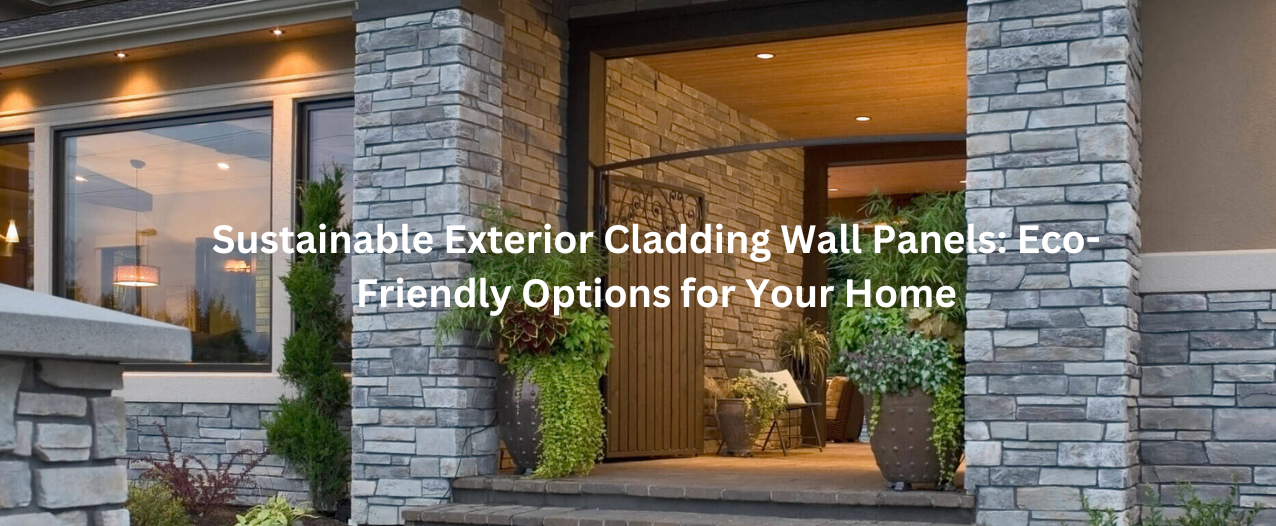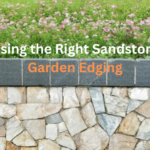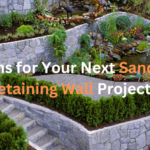You’re standing in front of your dream home, taking in its breathtaking exterior and wondering what really worked well in the outer part of your home. Then you realize, it’s the walls that aren’t just visually stunning; but tell a compelling story of sustainability and eco-conscious choices.
This is the transformative power of sustainable ‘exterior cladding wall panels.’ These panels do more than just upgrade the aesthetic appeal of your home—they play an important role in environmental conservation.
By choosing sustainable cladding, you’re not only making a stylish statement but also taking a significant step towards reducing your carbon footprint. These eco-friendly materials are designed to be durable, energy-efficient, and kind to the environment.
In this blog post, we’ll explore their numerous benefits, from environmental and economic advantages to health improvements. You’ll discover a variety of popular materials, each with its unique charm and sustainability credentials.
Moreover, we’ll provide practical tips to help you choose the perfect cladding option for your home. So, let’s uncover how these innovative panels can transform your home into a beacon of sustainability and style.
No matter if you’re going to build your dream house or renovate an existing one, sustainable exterior cladding wall panels offer a beautiful and responsible choice for your home’s exterior.
Understanding Sustainable Cladding
Let’s take a closer look at what makes sustainable cladding such a smart choice for your home. Sustainable cladding involves using eco-friendly materials for the exterior surfaces of buildings. But what does that really mean, and why is it important?
Eco-Friendly Materials
Sustainable cladding materials are selected for their minimal environmental impact. This means they are often made from recycled or renewable resources, which helps conserve natural resources and reduce waste.
For example, recycled metal cladding repurposes materials that might otherwise end up in landfills, while bamboo cladding uses a rapidly renewable resource that grows back quickly after harvesting.
Durability
One of the key benefits of sustainable cladding is its durability. These materials are designed to withstand the elements and last for many years, reducing the need for frequent replacements. This not only saves you money in the long run but also reduces the environmental impact associated with manufacturing and transporting new materials.
Energy Efficiency
Sustainable cladding can also improve your home’s energy efficiency. Many eco-friendly cladding materials have excellent insulating properties, helping to keep your home warm in the winter and cool in the summer. This can lead to lower energy bills and a reduced carbon footprint, as your home requires less energy for heating and cooling.
Reducing Carbon Footprint
By choosing sustainable cladding, you’re making a conscious decision to reduce your carbon footprint. The production of these materials typically involves less energy and fewer emissions compared to traditional building materials.
Additionally, many sustainable cladding options are recyclable at the end of their life cycle, further minimizing their environmental impact.
Contributing to a Healthier Planet
Opting for sustainable cladding is a step towards a healthier planet. By supporting the use of eco-friendly materials, you’re helping to promote sustainable practices in the construction industry. This not only benefits the environment but also encourages innovation and the development of new, greener building technologies.
Notably, when you select materials that are eco-friendly, durable, and energy-efficient, you can create beautiful and sustainable exterior cladding wall panels for your home. It’s a win-win situation that upgrades your living space while contributing to a healthier planet.
Benefits of Sustainable Exterior Cladding
Choosing sustainable exterior cladding for your home comes with a multitude of benefits that extend beyond just aesthetics. Below are the key highlights that will tell you how these eco-friendly materials can positively impact the environment, your wallet, and your health.
Environmental Benefits
You can witness a significant reduction in your carbon footprint when you opt for sustainable cladding materials like recycled metal. These materials are designed to have a minimal environmental impact. For instance, recycled metal cladding repurposes existing materials, reducing the need for new raw materials and the energy required to produce them.
Moreover, many of these materials can be recycled at the end of their life cycle, further minimizing waste and environmental impact.
Economic Benefits
While it’s true that the initial cost of sustainable cladding materials might be higher, one should consider it as a long-term investment. These materials are incredibly durable and require less maintenance compared to traditional options. For example, fiber cement and composite cladding are known for their longevity and resistance to weathering, pests, and fire.
This simply means fewer repairs and replacements over the years, translating to significant cost savings. Additionally, the improved energy efficiency of these materials can lower your heating and cooling bills, providing further economic benefits.
Health Benefits
Your choice of cladding can also have a profound impact on your indoor air quality and overall health. Sustainable cladding materials, such as natural wood and bamboo, are free from harmful chemicals and toxins that are often found in conventional building materials.
This means fewer volatile organic compounds (VOCs) being released into your home, leading to cleaner, healthier air. Improved indoor air quality can reduce the risk of respiratory issues and other health problems, creating a safer living environment for you and your family.
Popular Eco-Friendly Cladding Materials
Choosing the right cladding material for your home can be an important decision, especially when you’re aiming for sustainability. So let’s explore some of the most popular eco-friendly cladding materials, highlighting their unique benefits and why they might be the perfect fit for your home.
Recycled Metal Cladding
Recycled metal cladding, made from aluminum or steel, is a fantastic choice for modern and industrial-style homes. This material is incredibly durable and weather-resistant, standing up to the elements with ease.
Moreover, it’s 100% recyclable, meaning it can be reused over and over again without losing its quality. By choosing recycled metal, you’re reducing the demand for new raw materials and significantly minimizing your environmental impact. It’s a win-win for both your home and the planet.
Wood Cladding
There’s something timeless and versatile about wood cladding. When sourced sustainably, such as from FSC-certified forests, wood provides excellent insulation and a natural aesthetic that can enhance any home. Woods like cedar and redwood are particularly prized for their natural resistance to decay and pests, making them a durable choice.
The beauty of wood cladding lies in its ability to blend seamlessly with various architectural styles, from rustic to contemporary, while also being a renewable resource.
Bamboo Cladding
Bamboo is a superstar in the world of sustainable materials. This rapidly renewable resource grows incredibly fast, often reaching maturity in just a few years. Bamboo cladding offers strength and a unique appearance that can set your home apart.
It’s highly durable and resistant to weather conditions, making it an excellent choice for exterior applications. Harvesting bamboo causes minimal environmental damage, making it a truly eco-friendly option.
Fiber Cement Cladding
If you’re looking for a material that combines durability with low maintenance, fiber cement cladding might be the answer. Made from a mixture of cement, sand, and cellulose fibers, this cladding is known for its fire resistance and longevity.
It can mimic the appearance of wood or stone, offering versatility in design without the upkeep that natural materials might require. Fiber cement cladding is also resistant to pests and weather, making it a practical and sustainable choice for many homeowners.
Composite Cladding
Composite cladding is a blend of recycled wood fibers and plastic, creating a material that is both sustainable and low-maintenance. This cladding is resistant to weather, insects, and rot, making it ideal for various climates.
The combination of materials ensures that composite cladding is durable and long-lasting, while also providing a variety of finishes to suit different aesthetic preferences. It’s an excellent option for those looking to balance sustainability with practicality.
How to Choose the Right Cladding for Your Home?
When selecting exterior cladding wall panels, one should consider factors such as climate, home design, budget, and personal preferences. For instance, if you live in a humid area, materials like fiber cement or composite cladding might be more suitable due to their moisture resistance. On the other hand, if you prefer a natural look, wood or bamboo cladding could be the perfect choice.
Comparing different materials based on durability, maintenance, and environmental impact can help you make an informed decision. Consulting with professionals and researching suppliers, such as Maroota Sandstone Quarry, can also provide valuable insights into the best options for your home. Whether you’re considering a sandstone block retaining wall or sandstone log retaining walls, you can check our official site.
Installation and Maintenance Tips
Proper installation is also important for the longevity and performance of sustainable cladding. Ensure that the panels are installed by experienced professionals who follow best practices. Regular maintenance, such as cleaning and inspecting for damage, will help keep your cladding in top condition.
For instance, wood cladding may require periodic sealing or staining to protect it from the elements, while fiber cement and composite cladding typically need less frequent maintenance. Addressing any issues promptly can prevent more significant problems down the line.
Bottom Line
While concluding the blog it can said that sustainable exterior cladding wall panels offer numerous benefits, from environmental conservation to long-term cost savings and improved health.
When you choose eco-friendly options, you can create a home that is not only beautiful but also kind to the planet. Explore the various materials available and make an informed decision to enhance your home’s exterior sustainably.
To explore high-quality materials like concrete block retaining walls or the finest sandstone products, don’t forget to visit our official site, Maroota Sandstone Quarry.
FAQs
1. What is sustainable cladding?
Ans. Sustainable cladding involves using eco-friendly materials for the exterior surfaces of buildings, reducing environmental impact, and improving energy efficiency.
2. How does sustainable cladding benefit the environment?
Ans. It reduces the carbon footprint, conserves natural resources, and often involves materials that can be recycled or are renewable.
3. What are the most popular eco-friendly cladding materials?
Ans. Popular materials include recycled metal, FSC-certified wood, bamboo, fiber cement, and composite cladding.
4. How do I choose the right cladding for my home?
Ans. You can consider factors like climate, home design, budget, and personal preferences. Self-research and consult with professionals to find the best option.
5. What are the maintenance requirements for sustainable cladding?
Ans. Maintenance varies by material but generally includes regular cleaning and inspections. Some materials, like wood, may require periodic sealing or staining.




